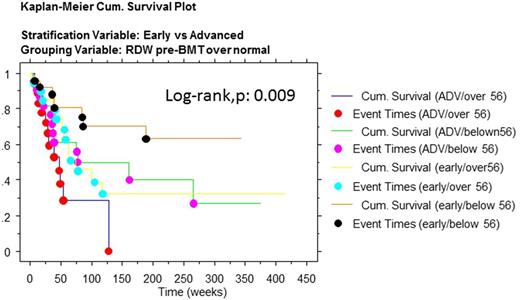Abstract
Background:
Red cell distribution width (RDW) is an erythrocyte index influenced by anisocytosis and useful in approaching patient with various types of anemia or suspected myelodysplasia. RDW can predict mortality in sepsis, chronic kidney diseases and cardiovascular disease, RDW has a prognostic value also in patients with breast cancer, lung cancer, glioblastoma, myeloma and chronic lymphocytic leukemia. No data, however, are available on the prognostic value of RDW in patients affected by acute leukemia. We studied prognostic value of RDW-SD assessed at pre-transplant evaluation, in acute leukemia patients who underwent allogeneic transplantation.
Methods:
We retrospectively studied the prognostic value of RDW-SD in a group of 94 adult acute leukemia patients affected by AML (70) ALL (19) or advanced MDS (5). RDW-SD was measured after patients had received induction and consolidation chemotherapy to achieve maximal anti-leukemic response. A MINDRAY BC6800 automatic cell counter was used. Patients, subsequently, underwent allogeneic transplantation from a sibling or from an alternative donors (MUD or Haplo-identical donors). Median age was 46 years (18-70). Ninths-five percent of patients received a fully myeloablative conditioning. Cytogenetic classification of leukemic cells was available in 95% of AML/MDS patients (72/75). Fifty-four percent of all patients were in an early phase of disease (1st complete remission) while 46% in the advanced phase (2nd CR or active disease). RDW-SD upper normal limit was 55 fL and patients were grouped according to this threshold. Data were analyzed by R software.
Results:
At baseline, before the transplant, an RDW-SD higher than normal (=/> 56 fL) was observed in 44% of all acute leukemia patients. RDW-SD correlates with MCV (r=0.611, p=0.0001) but not with other hematological parameters present at the time of RDW assessment. A high co-morbidity score (HTC-CI score 2-5) at the pre-transplant screening was a factor significantly associated to high RDW-SD, in fact, 27% of patients having an "RDW-SD over normal" had a comorbidity score of 2-5, while in the group of patients having an "RDW-SD within normal" a comorbidity score 2-5 was observed only in 9% (Chi-square-test p:0.02). The group of patients having an "RDW-SD over normal" had in respect to group "RDW-SD within normal" a higher serum LHD (p: 0.02). An unfavourable cytogenetics was observed in 26% of patients in the group "RDW-SD over normal" versus 8% in the group "RDW within normal" (p=0.10). The two groups of patients were not significantly different in age, gender, diagnosis, phase of the disease, level of WT-1 before transplant, previous transplantation, C-reactive protein, ferritin, creatinine and arterial diastolic pressure. In the whole set of patients, the Overall Survival at 3 y was 45% with a median follow up, for uncensored patients, of 99 weeks. OS at 3 years in the group "RDW within normal" was 61% versus 25% in the group "RDW-SD over normal" (log-rank, p=0-01). Differences in OS between these two groups was present also when patients were stratified according to cytogenetics or phase of disease (Fig 1). In univariate analysis other factors important for OS were phase of disease (p=0.004), graft from an alternative donor (p=0.03) and age (p=0.005). The comorbidity score was not an important factor for OS. In multivariate analysis, using Cox proportional hazard, factors important for OS remained age (HR: 1.040; CI: 1010-1070; P=0.008) and a pre-transplant "RDW-SD over normal " (HR, 3.274; CI: 1.694-6.328; p=0.0004). The group of patients having an "RDW over normal" had a Relapse Rate (RR) higher than the group having "RDW-SD within normal" (RR: 60% versus 30%, Gray test p= 0.05). Treatment related mortality (TRM) was 14% in the group "RDW within normal" versus 22% in the group "RDW over normal" (Gray test not significant).
Conclusions:
Abnormal RDW-SD is frequently found in acute leukemia patients treated by chemotherapy and in complete or partial response before allogeneic transplantation, "RDW-SD over normal" at time of pre-transplant screening is an independent negative prognostic factor for outcome after transplantation. The poor OS of the group of patients showing "RDW-SD over normal" is, at least in part, due to a higher relapse rate. The association of "RDW-SD over normal" and adverse cytogenetics deserves further studies.
No relevant conflicts of interest to declare.
Author notes
Asterisk with author names denotes non-ASH members.


This feature is available to Subscribers Only
Sign In or Create an Account Close Modal